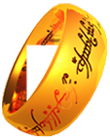Things of Middle-earth
Old Words and Names in the Shire
Type: Books & Scrolls
Description:A book written by Meriadoc Brandybuck in the Fourth Age:
In Brandy Hall there were many works dealing with Eriador and the history of Rohan. Some of these were composed or begun by Merry himself.... He also wrote a short treatise on Old Words and Names in the Shire, having special interest in discovering the kinship with the language of the Rohirrim of such 'shire-words' as mathom and old elements in place names.
The Fellowship of the Ring, LoTR Prologue, Note on the Shire Records
The Mannish languages that were related to the Westron should, it seemed to me, be turned into forms related to English. The language of Rohan I have accordingly made to resemble ancient English, since it was related both (more distantly) to the Common Speech, and (very closely) to the former tongue of the northern Hobbits, and was in comparison with the Westron archaic. In the Red Book it is noted in several places that when Hobbits heard the speech of Rohan they recognized many words and felt the language to be akin to their own, so that it seemed absurd to leave the recorded names and words of the Rohirrim in a wholly alien style.
In several cases I have modernized the forms and spellings of place-names in Rohan: as in Dunharrow or Snowbourn; but I have not been consistent, for I have followed the Hobbits. They altered the names that they heard in the same way, if they were made of elements that they recognized, or if they resembled place-names in the Shire; but many they left alone, as I have done, for instance, in Edoras 'the courts'. For the same reasons a few personal names have also been modernized, as Shadowfax and Wormtongue.
This assimilation also provided a convenient way of representing the peculiar local hobbit-words that were of northern origin. They have been given the forms that lost English words might well have had, if they had come down to our day. Thus mathom is meant to recall ancient English máthm, and so to represent the relationship of the actual Hobbit kast to R. [Rohirric] kastu. Similarly smial (or smile) 'burrow' is a likely form for a descendant of smygel, and represents well the relationship of Hobbit tran to R. trahan. Sméagol and Déagol are equivalents made up in the same way for the names Trahald 'burrowing, worming in', and Nahald 'secret' in the Northern tongues.
The Return of the King, LoTR Appendix F, The Languages and Peoples of the Third Age: On Translation
Contributors: Elena Tiriel 6.17.04; added Appendix tidbits: 6.19.04
